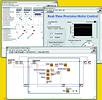Extending technology for automated instrumentation
June 2004
System Integration & Control Systems Design

National Instruments, a global leader in virtual instrumentation, recently released LabVIEW 7.1, a significant upgrade to that family of graphical development products.
LabVIEW 7.1 extends Express technology to automated instrumentation and realtime applications with new Express VIs (virtual instruments) for NI modular instruments and NI-DAQmx, advanced debugging and low-level execution timing for the LabVIEW 7.1 Real-Time Module.
"Last year, LabVIEW 7 Express introduced a revolutionary way to create test, measurement and control applications with configuration-based development and code-generation tools such as Express VIs and measurement assistants," said Ray Almgren, NI vice president of product marketing. "By extending Express technology to the broad spectrum of NI automated instrumentation, LabVIEW 7.1 simplifies development for all LabVIEW users, regardless of their hardware platforms."
NI continues to advance automated instrumentation for hardware platforms ranging from high-performance modular instruments to realtime data acquisition systems and handheld devices. With five new Express VIs for NI digitisers, signal generators and high-speed digital I/O, engineers can configure sophisticated measurements and acquire data with just a few mouse clicks. The redesigned NI-DAQmx measurement services software in LabVIEW 7.1, available in realtime applications for the first time, increases performance of single-loop PID applications by 30% and simplifies hardware-timed loop implementation. In addition, the new LabVIEW 7.1 PDA Module delivers more data acquisition functionality, including faster multichannel acquisition and analog and digital triggering. Engineers can use this module to create customised handheld DMM applications and communicate with Bluetooth-enabled devices.
LabVIEW 7.1 also introduces advanced execution timing and graphical debugging for low-level control and visibility of realtime system execution. With the new timed loop, and enhanced while loop, engineers can specify precise timing of code segments, coordinate multiple time-critical activities and define priority-based loops for creating multirate applications. To further optimise performance of their applications, engineers can use the new Execution Trace Toolkit with the Real-Time Module to quickly identify sources of jitter, such as memory allocation and race conditions.
In addition to speeding development of realtime applications on existing platforms, this release extends LabVIEW Real-Time to run on certified desktop PCs. Engineers can now create realtime systems by integrating the large installed base of PCI I/O hardware with desktop PCs. The new LabVIEW 7.1 FPGA Module, which also releases with LabVIEW 7.1, improves efficiency and functionality of embedded FPGA applications. The latest version features single-cycle while loops that execute multiple functions within a single 25 ns 'tick' of the 40 MHz global clock. With this new feature, engineers can use LabVIEW to develop FPGA code that executes as efficiently as hand-coded VHDL. They can also re-use their existing VHDL code in LabVIEW FPGA applications with a new HDL interface node. In addition, engineers now have three new FPGA targets, including the NI Compact Vision System for creating high-performance custom machine vision applications.
For more information contact Michael Hutton, National Instruments, 011 805 8197.
Further reading:
Containerised Electrical & Control System Powers Paste Plant in Botswana
System Integration & Control Systems Design
Delivering a complete, containerized solution for a mine’s paste plant in Botswana, this project stands as a model of modern EC&I execution — integrating electrical, control, and automation systems into
...
Read more...
Control system upgrade: Smelting
SAM Systems Automation & Management
System Integration & Control Systems Design
Systems Automation & Management recently completed a major control system upgrade in the smelting industry. The project was delivered on budget and achieved a positive ROI for the client.
Read more...
Gottwald drives upgrade: Ports and harbours
Abacus Automation
System Integration & Control Systems Design
In the ports and harbours sector, Abacus Automation completed a significant modernisation of a Gottwald crane, improving both operational reliability and serviceability.
Read more...
Mining industry upgrade: From ageing systems to maximum capacity
System Integration & Control Systems Design
Iritron recently undertook a major upgrade in the mining sector, focusing on washing and screening plants, jigs, thickeners, tailings, water systems, conveyors and reclaimers.
Read more...
Agogo Integrated West Hub Project: FPSO/subsea offshore Angola
Moore Process Controls
System Integration & Control Systems Design
The Agogo Integrated West Hub project represents a historic milestone in the FPSO and subsea industry, achieving first oil offshore of Angola. This project is the first FPSO deployment since ANPG’s establishment in 2019, and the first major project for Azule Energy since 2022.
Read more...
Integrated Robotics and Control Systems Deliver 45% Production Boost at Aquazania Waters Project and Industry
Process Dynamics
System Integration & Control Systems Design
Project and Industry Process Dynamics designed and commissioned a state-of-the-art Reverse Osmosis
(RO) water purification and automated bottle filling plant for Aquazania Waters in Linbro Park, Johannesburg.
...
Read more...
Digital transformation from the edge
DirectLogic Automation
System Integration & Control Systems Design
Edge-enabled PLCs are an accessible and affordable way for most users to collect and create value from use field-sourced data.
Read more...
Powering southern Africa’s industrial evolution for over five decades
Oilpower
System Integration & Control Systems Design
Established in 1974, Oilpower is a recognised name in South Africa’s hydraulic and pneumatic sector. What started as a small, family-run business has matured into a highly structured operation with specialised teams, experienced engineers and a reputation for technical excellence and reliability. Oilpower is celebrating its 50th anniversary this year
Read more...
Metal plant automation upgrade
ABB South Africa
System Integration & Control Systems Design
A combined compressor house (CCH) control system replacement project, undertaken by NJC, an ABB Authorised Value Provider (AVP), has won high praise from client ArcelorMittal.
Read more...
SIs - the channel’s conductors of light
Schneider Electric South Africa
System Integration & Control Systems Design
Today’s original equipment manufacturers are innovators in the truest sense, driving the absolute newest in technological advancement. While they develop advanced and often groundbreaking solutions, it is the system integrators who bring these innovations to life.
Read more...


